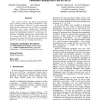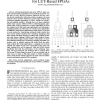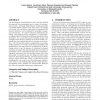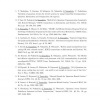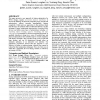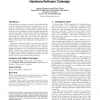FPGA
2006
ACM
14 years 3 months ago
2006
ACM
This paper presents experimental measurements of the differences between a 90nm CMOS FPGA and 90nm CMOS Standard Cell ASICs in terms of logic density, circuit speed and power cons...
FPGA
2006
ACM
14 years 3 months ago
2006
ACM
The high unit cost of FPGA devices often deters their use beyond the prototyping stage. Efforts have been made to reduce the part-cost of FPGA devices, resulting in the developmen...
FPGA
2006
ACM
14 years 3 months ago
2006
ACM
In this paper, we present reconfigurable hardware architecture for detecting semantics of streaming data on 1+ Gbps networks. The design leverages on the characteristics of contex...
FPGA
2006
ACM
14 years 3 months ago
2006
ACM
Due to their generic and highly programmable nature, FPGAs provide the ability to implement a wide range of applications. However, it is this nonspecific nature that has limited t...
FPGA
2006
ACM
14 years 3 months ago
2006
ACM
Abstract--Field-programmable gate-array (FPGA) logic synthesis and technology mapping have been studied extensively over the past 15 years. However, progress within the last few ye...
FPGA
2006
ACM
14 years 3 months ago
2006
ACM
The development of Reed-Solomon (RS) codes has allowed for improved data transmission over a variety of communication media. Although Reed-Solomon decoding provides a powerful def...
FPGA
2006
ACM
14 years 3 months ago
2006
ACM
While previous research has shown that FPGAs can efficiently implement many types of computations, their flexibility inherently limits their clock rate. Several research groups ha...
FPGA
2004
ACM
14 years 3 months ago
2004
ACM
FPGA
2004
ACM
14 years 3 months ago
2004
ACM
This paper presents a new approach to timing optimization for FPGA designs, namely incremental physical resynthesis, to answer the challenge of effectively integrating logic and p...
FPGA
2004
ACM
14 years 3 months ago
2004
ACM
Embedded systems combine a processor with dedicated logic to meet design specifications at a reasonable cost. The attempt to amalgamate two distinct design environments introduces...

